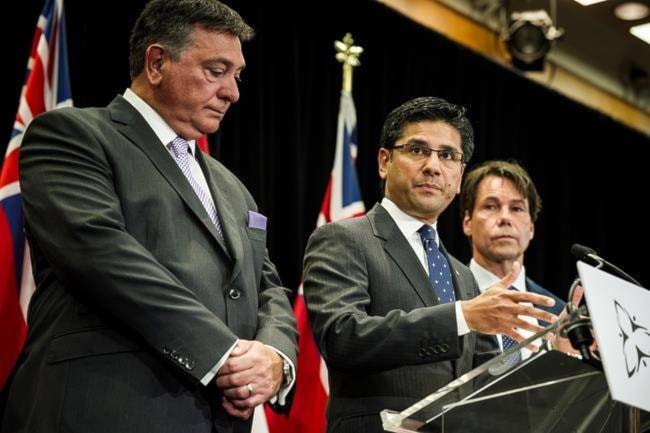Ontario is the first province out of the gate with a detailed plan to sell and distribute recreational marijuana when Ottawa legalizes it next summer.
The Liberal government announced Friday it will sell marijuana in as many as 150 dedicated stores run by the province’s liquor control board. Those looking to purchase marijuana when it becomes legal across the country will be subject to the same age and usage restrictions currently in place for alcohol, said Attorney General Yasir Naqvi.
The process of purchasing recreational cannabis will closely mimic the one currently in place at the Liquor Control Board of Ontario.
READ MORE:
READ MORE:
Naqvi said residents 19 or older will be able to purchase marijuana at separate retail outlets or through a website run by the LCBO that should be ready for business by next July.
Consumption of legal weed will not be allowed in public spaces or workplaces and should be confined to private residences, Naqvi said. However, he said the government will explore the possibility of allowing marijuana-licensed establishments in the future.
The province expects to have all the stores operational across the province by 2020, with the first 40 stores opening next summer. Those stores will only sell marijuana and not alcohol.
The federal government introduced legislation in April with a goal of legalizing and regulating the use of recreational pot by July 1, 2018, but left it up to individual provinces to design their own distribution system and usage regulations.
Ontario has jumped ahead of most other provinces and territories, many of which are either in the early stages of crafting their legalization frameworks or have just started public consultations. Last Friday, a special legislative committee tasked with examining how New Brunswick will set up its framework released a set of recommendations. That province has yet to implement those recommendations.
In July, Canada’s premiers told the federal government they needed more time to get their rules in place before Ottawa went ahead with the marijuana legalization. They asked for clarification around road safety and enforcement, preparation and training on distribution, taxation, public education, and the impact legalization might have on the black market.
But despite the concerns, Ontario is moving ahead and Naqvi said the time-tested model at the LCBO made sense as a blueprint for cannabis in the province.
One of the government’s priorities, he said, involves clamping down on illegal distribution channels. He made it clear that will include dispensaries that have cropped up in recent months in anticipation of widespread legalization.
“Illicit cannabis dispensaries are not legal now and will not be legal retailers under the new model,” Naqvi said. “… These pot dispensaries are illegal and will be shut down. If you operate one of these facilities, consider yourself on notice.”
Naqvi said setting the minimum purchasing age at 19 is intended to protect youth from potential drug use. The new regulations, however, will also contain language allowing police to confiscate small amounts of pot from those under 19 without incurring criminal charges.
Asked about expected revenues, Finance Minister Charles Sousa could provide no estimates, saying the market conditions and federal tax levels will impact the bottom line and are unclear.
“Frankly, this is uncharted territory and we’re going to have to monitor it and see how it develops,” Sousa said.
He said the government has been working on the pot file for about a year.
“We are running out of time,” he said. “We have to be prepared by next year.”
Cannabis activist Jodie Emery predicted Ontario’s plan will limit the supply of marijuana in the province and will contribute to the growth of the black market.
“I’ve been worried from the beginning that the so-called legalization is nothing more that Prohibition 2.0 with cops and politicians looking to make money themselves,” Emery said.
Sousa could not say what the start-up costs for the stores will be but expects they will be recovered over time.
He said legislation regulating the control of marijuana will be introduced in the fall.
Ontario’s opposition parties both panned the government plan. Progressive Conservative community safety critic Laurie Scott said the government must have strong measures to crack down on drug-impaired driving and to address concerns raised by public health officials.
“We are calling on the (Premier) Kathleen Wynne government to ensure that law enforcement, public health and local communities are properly consulted and have the tools they need as the Liberals roll out this proposal,” Scott said in a statement.
NDP attorney general critic Gilles Bisson said the government has failed to deliver a comprehensive plan for safe marijuana distribution.
“Now, we’re left to ask if the number of locations is correct, where they’ll be located, how communities will be involved in the decision process, and how pot products will be priced and taxed,” Bisson said.
The federal government has pledged to work with provinces and commit resources to pot-related needs like public security, policing and educational campaigns. On Friday, Minister of Public Safety and Emergency Preparedness Ralph Goodale said the federal government will spend $274 million to bolster law enforcement and border efforts to “detect and deter” drug-impaired driving and enforce the proposed cannabis legalization and regulation.
“We are working closely with our partners to ensure law enforcement is well trained, to build capacity across the country and at our border, and to raise awareness about the dangers of drug-impaired driving,” Goodale said in a statement.
Shawn Jeffords, The Canadian Press



